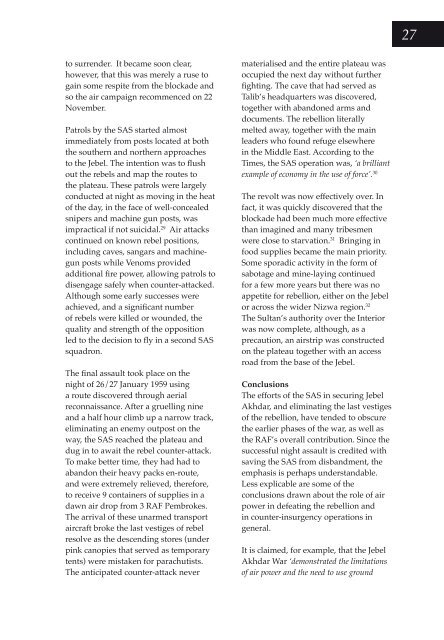REVIEW - Royal Air Force Centre for Air Power Studies
REVIEW - Royal Air Force Centre for Air Power Studies
REVIEW - Royal Air Force Centre for Air Power Studies
Create successful ePaper yourself
Turn your PDF publications into a flip-book with our unique Google optimized e-Paper software.
to surrender. It became soon clear,<br />
however, that this was merely a ruse to<br />
gain some respite from the blockade and<br />
so the air campaign recommenced on 22<br />
November.<br />
Patrols by the SAS started almost<br />
immediately from posts located at both<br />
the southern and northern approaches<br />
to the Jebel. The intention was to flush<br />
out the rebels and map the routes to<br />
the plateau. These patrols were largely<br />
conducted at night as moving in the heat<br />
of the day, in the face of well-concealed<br />
snipers and machine gun posts, was<br />
impractical if not suicidal. 29 <strong>Air</strong> attacks<br />
continued on known rebel positions,<br />
including caves, sangars and machinegun<br />
posts while Venoms provided<br />
additional fire power, allowing patrols to<br />
disengage safely when counter-attacked.<br />
Although some early successes were<br />
achieved, and a significant number<br />
of rebels were killed or wounded, the<br />
quality and strength of the opposition<br />
led to the decision to fly in a second SAS<br />
squadron.<br />
The final assault took place on the<br />
night of 26/27 January 1959 using<br />
a route discovered through aerial<br />
reconnaissance. After a gruelling nine<br />
and a half hour climb up a narrow track,<br />
eliminating an enemy outpost on the<br />
way, the SAS reached the plateau and<br />
dug in to await the rebel counter-attack.<br />
To make better time, they had had to<br />
abandon their heavy packs en-route,<br />
and were extremely relieved, there<strong>for</strong>e,<br />
to receive 9 containers of supplies in a<br />
dawn air drop from 3 RAF Pembrokes.<br />
The arrival of these unarmed transport<br />
aircraft broke the last vestiges of rebel<br />
resolve as the descending stores (under<br />
pink canopies that served as temporary<br />
tents) were mistaken <strong>for</strong> parachutists.<br />
The anticipated counter-attack never<br />
materialised and the entire plateau was<br />
occupied the next day without further<br />
fighting. The cave that had served as<br />
Talib’s headquarters was discovered,<br />
together with abandoned arms and<br />
documents. The rebellion literally<br />
melted away, together with the main<br />
leaders who found refuge elsewhere<br />
in the Middle East. According to the<br />
Times, the SAS operation was, ‘a brilliant<br />
example of economy in the use of <strong>for</strong>ce’. 30<br />
The revolt was now effectively over. In<br />
fact, it was quickly discovered that the<br />
blockade had been much more effective<br />
than imagined and many tribesmen<br />
were close to starvation. 31 Bringing in<br />
food supplies became the main priority.<br />
Some sporadic activity in the <strong>for</strong>m of<br />
sabotage and mine-laying continued<br />
<strong>for</strong> a few more years but there was no<br />
appetite <strong>for</strong> rebellion, either on the Jebel<br />
or across the wider Nizwa region. 32<br />
The Sultan’s authority over the Interior<br />
was now complete, although, as a<br />
precaution, an airstrip was constructed<br />
on the plateau together with an access<br />
road from the base of the Jebel.<br />
Conclusions<br />
The ef<strong>for</strong>ts of the SAS in securing Jebel<br />
Akhdar, and eliminating the last vestiges<br />
of the rebellion, have tended to obscure<br />
the earlier phases of the war, as well as<br />
the RAF’s overall contribution. Since the<br />
successful night assault is credited with<br />
saving the SAS from disbandment, the<br />
emphasis is perhaps understandable.<br />
Less explicable are some of the<br />
conclusions drawn about the role of air<br />
power in defeating the rebellion and<br />
in counter-insurgency operations in<br />
general.<br />
It is claimed, <strong>for</strong> example, that the Jebel<br />
Akhdar War ‘demonstrated the limitations<br />
of air power and the need to use ground<br />
27

















